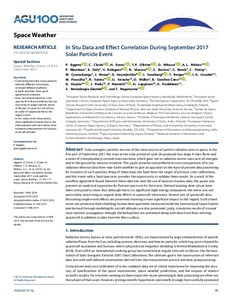In Situ Data and Effect Correlation During September 2017 Solar Particle Event
Jiggens P; Clavie C; Evans H; O'Brien TP; Witasse O; Mishev AL; Nieminen P; Daly E; Kalegaev V; Vlasova N; Borisov S; Benck S; Poivey C; Cyamukungu M; Mazur J; Heynderickx D; Sandberg I; Berger T; Usoskin IG; Paassilta M; Vainio R; Straube U; Muller D; Sanchez-Cano B; Hassler D; Praks J; Niemela P; Leppinen H; Punkkinen A; Aminalragia-Giamini S; Nagatsuma T; Nagatsuma T
In Situ Data and Effect Correlation During September 2017 Solar Particle Event
Jiggens P
Clavie C
Evans H
O'Brien TP
Witasse O
Mishev AL
Nieminen P
Daly E
Kalegaev V
Vlasova N
Borisov S
Benck S
Poivey C
Cyamukungu M
Mazur J
Heynderickx D
Sandberg I
Berger T
Usoskin IG
Paassilta M
Vainio R
Straube U
Muller D
Sanchez-Cano B
Hassler D
Praks J
Niemela P
Leppinen H
Punkkinen A
Aminalragia-Giamini S
Nagatsuma T
Nagatsuma T
AMER GEOPHYSICAL UNION
Julkaisun pysyvä osoite on:
https://urn.fi/URN:NBN:fi-fe2021042824962
https://urn.fi/URN:NBN:fi-fe2021042824962
Tiivistelmä
Solar energetic particles are one of the main sources of particle radiation seen in space. In the first part of September 2017 the most active solar period of cycle 24 produced four large X-class flares and a series of (interplanetary) coronal mass ejections, which gave rise to radiation storms seen over all energies and at the ground by neutron monitors. This paper presents comprehensive cross comparisons of in situ radiation detector data from near-Earth satellites to give an appraisal on the state of present data processing for monitors of such particles. Many of these data sets have been the target of previous cross calibrations, and this event with a hard spectrum provides the opportunity to validate these results. As a result of the excellent agreement found between these data sets and the use of neutron monitor data, this paper also presents an analytical expression for fluence spectrum for the event. Derived ionizing dose values have been computed to show that although there is a significant high-energy component, the event was not particularly concerning as regards dose effects in spacecraft electronics. Several sets of spacecraft data illustrating single event effects are presented showing a more significant impact in this regard. Such a hard event can penetrate thick shielding; human dose quantities measured inside the International Space Station and derived through modeling for aircraft altitudes are also presented. Lastly, simulation results of coronal mass ejection propagation through the heliosphere are presented along with data from Mars-orbiting spacecraft in addition to data from the Mars surface.
Kokoelmat
- Rinnakkaistallenteet [27094]
